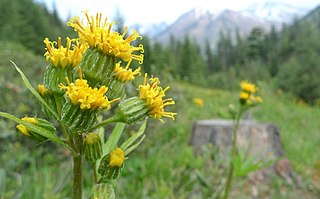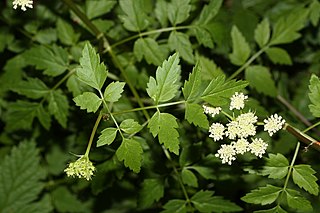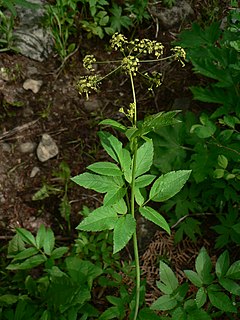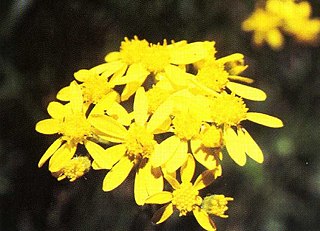
In botany, the petiole is the stalk that attaches the leaf blade to the stem, and is able to twist the leaf to face the sun. This gives a characteristic foliage arrangement to the plant. Outgrowths appearing on each side of the petiole in some species are called stipules. Leaves with a petiole are said to be petiolate, while leaves lacking a petiole are called sessile or apetiolate.

Cacaliopsis is a monotypic genus of flowering plants in the aster family, Asteraceae, containing the single species Cacaliopsis nardosmia. It is known by the common name silvercrown. It is native to western North America.

Boykinia major is a species of flowering plant in the saxifrage family known by the common name large boykinia. It is native to the western United States from California to Montana, where it grows in shady forest understory and wet mountain meadows. It is a rhizomatous perennial herb producing large leaves with blades up to 50 centimeters long, borne on petioles up to 35 centimeters in length. Each leaf has several lobes which are often sharply toothed along the edges. The inflorescence reaches up to a meter tall on a thin stem. It bears a dense, flat-topped array of many small white flowers with yellowish centers, each with five pointed sepals and five larger rounded or oval petals.

Oenanthe sarmentosa is a species of flowering plant in the family Apiaceae known by the common name water parsley. It is native to western North America from Alaska to California, where it grows in wet areas, such as streambanks. It is sometimes aquatic, growing in the water. The plant has been used in cultivation in wetlands, and the recent discovery of several colonies growing by a stream in Illinois demonstrates its capacity to become a noxious weed if it is introduced elsewhere. This is a perennial herb growing to a maximum height near 1.5 meters. The leaves have blades up to 30 centimeters long borne on petioles up to 35 centimeters in length. The parsley-like leaf blade is divided into serrated, lobed leaflets. The inflorescence is a compound umbel of many flowers with bright white to red-tinged petals.

Osmorhiza depauperata is a species of flowering plant in the carrot family known by the common names bluntseed sweetroot and blunt-fruited sweet-cicely.

Osmorhiza occidentalis is a species of flowering plant in the family Apiaceae known by the common name western sweet cicely or western sweetroot.

Ranunculus alismifolius is a species of buttercup known by the common name plantainleaf buttercup. It is native to western North America from British Columbia to California to Colorado, where it grows in moist mountain habitat such as meadows, streambanks, and bogs, becoming common to abundant in some places. It is somewhat variable in appearance and there are several varieties which can be hard to tell apart. In general the plant is a perennial herb producing a few usually upright to erect, branching stems from a fleshy, fibrous root system. It can be up to half a meter tall, or it can remain quite short and clumpy. The leaves vary in shape, the lower ones with oval blades and the upper linear to lance-shaped, all borne on long petioles. The inflorescence bears one or more flowers, each on a long pedicel. The flower has up to 12 yellow petals and many yellow stamens and pistils at the center. The fruit is an achene, borne in a spherical cluster of 12 or more.

Ranunculus eschscholtzii is a species of buttercup flower known by the common name Eschscholtz's buttercup.
Ranunculus hydrocharoides is a species of buttercup known by the common names frogbit buttercup, or frog's-bit buttercup. It is native to western North America, including the southwestern United States and Mexico. It is also known from Guatemala. It is aquatic or semi-aquatic, growing floating in water or in wet land near water. Typical habitat includes marshes, streams, and lakes. Stems are up to 25 centimeters long, prostrate on the ground when terrestrial, or floating when aquatic. The shiny green leaves have heart-shaped or oval blades up to 3 centimeters long which are borne on petioles which may be 15 centimeters in length. Flowers have 5 to 8 shiny yellow petals a few millimeters long with many stamens and pistils at the center. The fruit is an achene borne in a spherical cluster of 9 or more.

Ranunculus muricatus is a species of buttercup known by the common names rough-fruited buttercup and spinyfruit buttercup. It is native to Europe, but it can be found in many other places in the world, including parts of Africa, Australia, and the western and eastern United States, as an introduced species and agricultural and roadside weed. It grows in wet habitats, such as irrigation ditches. It is an annual or sometimes biennial herb producing a mostly hairless stem up to half a meter long which may grow erect or decumbent along the ground. The leaves have blades a few centimetres in length which are deeply divided into three lobes or split into three leaflets. They are hairless to hairy in texture, and are borne at the tips of long petioles. The flower has five shiny yellow petals under 1 centimetre (0.4 in) long around a lobed central receptacle studded with many stamens and pistils. The fruit is a spiny achene borne in a spherical cluster of 10 to 20.

Packera cana is a species of flowering plant in the aster family known by the common name woolly groundsel. It is native to western and central North America, where it can be found in a wide array of habitat types at all elevations from grassland to the alpine climates of mountain peaks.
Packera subnuda is a species of flowering plant in the aster family known by the common names Buek's groundsel and cleftleaf groundsel. It is native to western North America from the Northwest Territories to northern California to Wyoming, where it grows in high mountain meadows in subalpine and alpine climates.
Packera ganderi is a rare species of flowering plant in the aster family known by the common name Gander's ragwort. It is endemic to southern California, where it is known from a few occurrences in San Diego and Riverside Counties.

Senecio hydrophiloides is a species of flowering plant in the aster family known by the common names tall groundsel and sweet marsh ragwort. It is native to western North America from British Columbia and Alberta to northern California to Utah, where it grows in wet meadows and similar habitat. It is a biennial or perennial herb producing a single erect stem or a cluster of a few stems which may exceed one meter in maximum height. The plants are green to red in color and usually without hairs, but new growth can be woolly. The leaves are lance-shaped to oval with toothed edges, the blades up to 25 centimeters long and borne on long winged petioles. The leaves are firm and sometimes a bit fleshy. The inflorescence is a loose or dense cluster of up to 30 or more flower heads lined with black-tipped phyllaries. They contain many yellowish disc florets at the center and often have some yellow ray florets, though these are sometimes absent. Senecio Hydrophiloides can cause Dermatitis.

Senecio hydrophilus is a species of flowering plant in the aster family known by the common names water ragwort and alkali-marsh ragwort. It is native to western North America from British Columbia to California to Colorado, where it grows in swampy places such as marshes. It can grow in standing water, including alkaline and salty water. It is a biennial or perennial herb producing a single erect stem or a cluster of a few stems which may exceed one meter in maximum height, at times approaching two meters. The stem is hollow, waxy in texture, and often pale green in color, and it emerges from a small caudex. The thick leaves are lance-shaped to oval with smooth or toothed edges, the blades up to 20 centimeters long and borne on petioles. Smaller leaves occur farther up the stem. The inflorescence is one or more large, spreading clusters of many flower heads. They contain many yellowish disc florets at the center and sometimes have small yellow ray florets as well.

Stanleya elata is a species of flowering plant in the family Brassicaceae known by the common name Panamint princesplume. It is native to the desert mountains of eastern California and western Nevada, where it grows in rocky and scrubby habitat types. It may also occur in Arizona. It is a perennial herb producing one or more erect stems reaching about 1.5 meters in maximum height. They are hairless and often waxy in texture. The thick, leathery leaves have lance-shaped or oblong blades with smooth or toothed edges measuring up to 15 centimeters long. They are borne on petioles. The top of the stem is occupied by a long inflorescence which is a dense, snaking raceme of many flowers. Each flower has four narrow, threadlike yellow or whitish petals each about a centimeter long and a millimeter wide. The fruit is a long, thin, wormlike silique which may be 10 centimeters in length. It contains tiny seeds.

Thalictrum occidentale is a species of flowering plant in the buttercup family known by the common name western meadow-rue. It is native to northwestern North America from Alaska and western Canada to northern California to Wyoming and Colorado, where it grows in shady habitat types such as forest understory and more open, moist habitat such as meadows.

Trautvetteria is a genus of flowering plants in the buttercup family. Today it is often considered a monotypic genus, containing only one species, Trautvetteria caroliniensis, which is known by the common names Carolina bugbane, false bugbane, and tassel-rue. A second species, T. japonica, is now generally considered a variety of this species. The genus is named for the botanist Ernst Rudolf von Trautvetter.

Cystopteris montana, previously classified as Athyrium montanum, is a species of fern known by the common name mountain bladderfern. It occurs throughout the high latitudes of the Northern Hemisphere, in Eurasia, Greenland, and Alaska, and throughout Canada. It is also present in the higher elevations in Colorado farther south.

Haumania liebrechtsiana is a species of plant in the family Marantaceae. It grows as an understorey herb or climber in tropical forests in Central Africa. The leaves and shoots are eaten by gorillas and chimpanzees, and the leaves and stems have traditional uses.
















